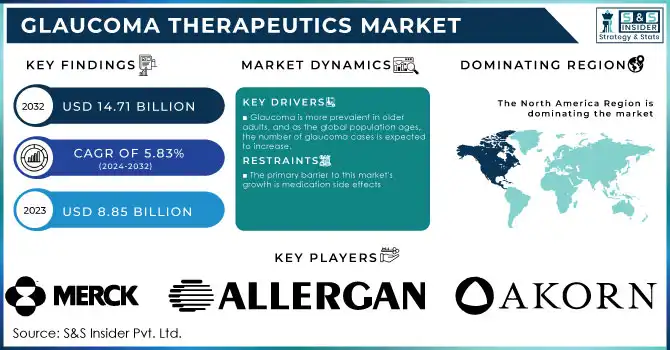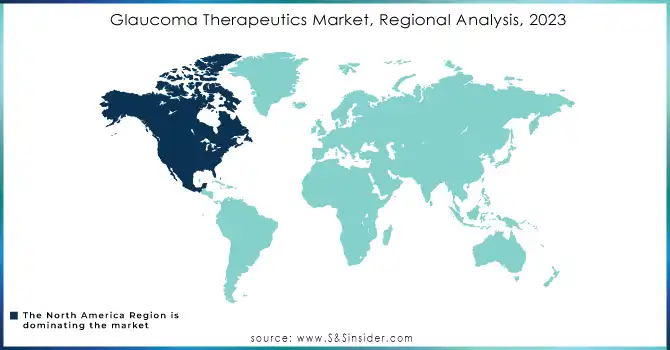Glaucoma Therapeutics Market Report Scope & Overview:

Get more information on Glaucoma Therapeutics Market - Request Sample Report
The Glaucoma Therapeutics Market size was USD 8.85 billion in 2023 and is expected to Reach USD 14.71 billion by 2032 and grow at a CAGR of 5.83% over the forecast period of 2024-2032.
The Glaucoma Therapeutics Market refers to the pharmaceutical and therapeutic products and services used in the treatment of glaucoma, a group of eye disorders characterized by damage to the optic nerve, which can lead to vision loss and blindness if left untreated. Glaucoma is caused by increased intraocular pressure (IOP) in the eye, which can result from a buildup of aqueous humour, the fluid that nourishes the eye. The condition affects a significant number of people worldwide and is one of the leading causes of irreversible blindness. The Glaucoma Therapeutics Market encompasses various treatment options designed to lower intraocular pressure and prevent further damage to the optic nerve. These treatments can include medications in the form of eye drops, oral medications, or injectable formulations.
Some common types of medications used for glaucoma treatment include prostaglandin analogues, beta blockers, alpha agonists, and carbonic anhydrase inhibitors. In addition to medication, other treatment modalities for glaucoma include laser therapy and surgical procedures. Laser therapy, such as selective laser trabeculoplasty (SLT) and laser peripheral iridotomy (LPI), is used to improve the drainage of fluid from the eye and reduce intraocular pressure. Surgical procedures like trabeculectomy and glaucoma drainage devices are performed when medication and laser therapy are not sufficient to control the condition.
The Glaucoma Therapeutics Market is driven by factors such as the increasing prevalence of glaucoma due to ageing populations, rising awareness about the disease, advancements in diagnostic techniques, and growing demand for effective treatment options. Additionally, ongoing research and development efforts aimed at developing innovative therapies further contribute to the expansion of this market. It is worth noting that market dynamics and specific product offerings within the Glaucoma Therapeutics Market can change over time due to advancements in medical technology, regulatory developments, and new treatment discoveries. Therefore, it's essential to consult the most up-to-date sources and industry reports for the latest information on the market.
GLAUCOMA THERAPEUTICS MARKET DYNAMICS
DRIVERS:
-
Glaucoma is more prevalent in older adults, and as the global population ages, the number of glaucoma cases is expected to increase.
-
The main factor driving this market is the rising prevalence of glaucoma.
Globally, glaucoma is one of the main causes of permanent blindness. The rising prevalence of glaucoma cases, particularly in emerging economies, drives the demand for glaucoma therapeutics.
RESTRAIN:
-
The expiration of patents for certain glaucoma medications allows generic versions to enter the market, leading to increased competition and potentially lower prices for branded drugs.
-
The primary barrier to this market's growth is medication side effects.
Adverse side effects from certain glaucoma drugs might include ocular discomfort, redness, and systemic effects. These adverse effects may make patients less compliant, which might result in their seeking out other therapies or stopping therapy entirely.
OPPORTUNITY:
-
The increasing prevalence of glaucoma globally provides an opportunity for pharmaceutical companies and healthcare providers to expand their product offerings and services to meet the growing demand for glaucoma therapeutics.
-
The largest opportunity in this sector is improvements in drug delivery systems.
Companies in the glaucoma therapeutics industry can gain a competitive edge by creating more effective and patient-friendly drug delivery methods, such as sustained-release implants or innovative eye drop formulations, to improve treatment compliance and patient outcomes.
CHALLENGES:
-
Regular drug usage and long-term care are necessary for glaucoma. However, certain patients may struggle with therapy compliance and adherence, which can result in less-than-ideal results and disease progression.
-
High Treatment Costs are a significant barrier in this sector.
The cumulative cost of long-term glaucoma treatment can be a burden for patients, particularly those without adequate health insurance coverage. The high cost of medications and surgical procedures may hinder access to treatment for some individuals.
IMPACT OF RUSSIA-UKRAINE WAR
As the Ukraine situation worsens, healthcare organisations face significant hurdles in manufacturing, access, and supply chain. Naturally, the main objectives for organisations operating in or with Ukraine are personnel safety and patient access to crucial pharmaceuticals and supplies. Aside from that, there is a possibility of long-term disruption in global supply networks, such as increases in raw materials and shipping costs. Medical technology businesses, in particular, are suffering challenges as freight and shipping prices rise.
Because pharma and medtech sales in Russia and Ukraine are less than 3% of global sales, the impact on enterprises abroad is not particularly severe. The difficulties stem from being able to fly items above airspace. There is a higher expense of doing so, as well as the macroeconomic inflation caused by the conflict. Looking especially at Russia, there are currently concerns about patent and intellectual property protection for pharmaceuticals and similar items in that market. If Russia decides not to recognize patents from hostile nations, where many large corporations are headquartered, the impact of items becoming quickly generic in Russia and what that truly means for global markets. All of these facts are driving the need for Glaucoma Therapeutics Market, as does the ageing population. The Glaucoma Therapeutics Market size increases up to 3.1-3.5%.
IMPACT OF ONGOING RECESSION
Because patient demand is only partially impacted by the economy, optometry and the eye-care business as a whole do better than most industries. According to IBISWorld, which specialises in business analysis and industry studies, patients are still cutting back, and this will have an impact on your practice. According to the research, a fall in per capita income among patients would affect how frequently they return for eye treatment as well as their spending on other goods and services supplied by optometrists. Optometrists may weather the recession by expanding and utilising their referral networks. According to the survey, by staying in touch with patients, practitioners can retain office visits and income. Because of all this data, Glaucoma Therapeutics Market is growing 3-4% in a ongoing recession.
KEY MARKET SEGMENTATION
By Drug Class
-
Prostaglandins Analogs
-
Beta Blockers
-
Carbonic Anhydrase Inhibitors
-
Alpha Adrenergic Agonists
-
Combination Drugs
-
Others
By Disease Indication
-
Angle Closure Glaucoma
-
Open Angle Glaucoma
-
Others
By Distribution Channel
-
Retail Pharmacy
-
Hospital Pharmacy
GLAUCOMA THERAPEUTICS MARKET REGIONAL ANALYSIS
North America: North America leads the glaucoma treatments industry, followed by Asia Pacific. Diabetes incidence, ocular illnesses, and an increase in the number of blind and visually impaired persons seeking glaucoma treatment are likely to fuel growth in the glaucoma therapeutics market in these regions.
Asia Pacific: A growing elderly population in nations like China and Japan is thought to be the reason why Asia Pacific would have the biggest growth in the market. Due to government initiatives and awareness programmes to eliminate blindness, Asia Pacific is likely to gain substantial traction during the forecast period, increasing demand for glaucoma medicines in this region. Last but not least, due to a lack of diagnostic resources for glaucoma and a lesser level of knowledge of the condition, the markets in Latin America, the Middle East, and Africa are significantly smaller.
Need any customization research on Glaucoma Treatments Market - Enquiry Now
REGIONAL COVERAGE:
North America
-
US
-
Canada
-
Mexico
Europe
-
Eastern Europe
-
Poland
-
Romania
-
Hungary
-
Turkey
-
Rest of Eastern Europe
-
-
Western Europe
-
Germany
-
France
-
UK
-
Italy
-
Spain
-
Netherlands
-
Switzerland
-
Austria
-
Rest of Western Europe
-
Asia Pacific
-
China
-
India
-
Japan
-
South Korea
-
Vietnam
-
Singapore
-
Australia
-
Rest of Asia Pacific
Middle East & Africa
-
Middle East
-
UAE
-
Egypt
-
Saudi Arabia
-
Qatar
-
Rest of Middle East
-
-
Africa
-
Nigeria
-
South Africa
-
Rest of Africa
-
Latin America
-
Brazil
-
Argentina
-
Colombia
-
Rest of Latin America
Key Players
Some major players in Glaucoma Therapeutics Market are Merck & Co. Inc, Allergan, Bausch & Lomb Incorporated, Akorn Inc, Teva Pharmaceuticals, Oculis S.A., Alcon, Santen, Pfizer, Nanodropper, Inc., and other players.
RECENT DEVELOPMENTS
In 2022: According to interim Phase I results published in 2022 by Ocular Therapeutix for their product candidate OTX-TIC, a single implant can successfully lower intraocular pressure (1OP) over an extended length of time without endangering corneal health. In a Phase, I prospective, randomised, controlled study, OTX-TIC is now being assessed for the treatment of primary open-angle glaucoma and ocular hypertension in the US.
Abb Vie Inc: Abb Vie Inc. finished the strategic purchase of Allergan plc in 2020. AbbVie Inc. has been able to position itself as a market leader in the glaucoma sector because of this purchase.
Senju Pharmaceutical Co Ltd: Senju Pharmaceutical Co Ltd. announced the launch of AIBETA, a combination medication to treat glaucoma and hypertension, in Japan in 2019.
| Report Attributes | Details |
| Market Size in 2023 | USD 8.85 Billion |
| Market Size by 2032 | USD 14.71 Billion |
| CAGR | CAGR of 5.83% From 2024 to 2032 |
| Base Year | 2023 |
| Forecast Period | 2024-2032 |
| Historical Data | 2020-2022 |
| Report Scope & Coverage | Market Size, Segments Analysis, Competitive Landscape, Regional Analysis, DROC & SWOT Analysis, Forecast Outlook |
| Key Segments | • By Drug Class (Prostaglandins Analogs, Beta Blockers, Carbonic Anhydrase Inhibitors, Alpha Adrenergic Agonists, Combination Drugs, Others) • By Disease Indication (Angle Closure Glaucoma, Open Angle Glaucoma, Others) • By Distribution Channel (Online Pharmacy, Retail Pharmacy, and Hospital Pharmacy) |
| Regional Analysis/Coverage | North America (US, Canada, Mexico), Europe (Eastern Europe [Poland, Romania, Hungary, Turkey, Rest of Eastern Europe] Western Europe] Germany, France, UK, Italy, Spain, Netherlands, Switzerland, Austria, Rest of Western Europe]). Asia Pacific (China, India, Japan, South Korea, Vietnam, Singapore, Australia, Rest of Asia Pacific), Middle East & Africa (Middle East [UAE, Egypt, Saudi Arabia, Qatar, Rest of Middle East], Africa [Nigeria, South Africa, Rest of Africa], Latin America (Brazil, Argentina, Colombia Rest of Latin America) |
| Company Profiles | Merck & Co. Inc, Allergan, Bausch & Lomb Incorporated, Akorn Inc, Teva Pharmaceuticals, Oculis S.A., Alcon, Santen, Pfizer, Nanodropper, Inc. |
| Key Drivers | • Glaucoma is more prevalent in older adults, and as the global population ages, the number of glaucoma cases is expected to increase. • The main factor driving this market is the rising prevalence of glaucoma. |
| Market Restraints | • The expiration of patents for certain glaucoma medications allows generic versions to enter the market, leading to increased competition and potentially lower prices for branded drugs. • The primary barrier to this market's growth is medication side effects. |


